Municipal Finance in the Face of Falling Property Values
The fall in property values associated with the recent recession has caused a decline in property taxes which may be amplifying local government budget crises across the country. Cuyahoga County is set to reappraise property values in 2012, and when it does it may only then absorb the full force of the housing market losses caused by the recession. We estimate the potential losses in property values and the county’s tax base and find that the impact could be significant.
The fall in property values associated with the recent recession has caused a decline in property taxes which may beamplifying local government budget crises across the country. Cuyahoga County is set to reappraise property values in2012, and when it does it may only then absorb the full force of the housing market losses caused by the recession. Weestimate the potential losses in property values and the county’s tax base and find that the impact could be significant.
Historically, recessions tend to trigger a drop in tax revenue and an increased demand for government services, which stresses government budgets. The most recent recession was no different, but this time, declines in municipal tax revenues have been more acute. At fault mostly are a prolonged period of high unemployment and a sluggish economic recovery, which have been compounded by a drop in transfer payments from state and federal governments.
Another factor that is contributing to the current sharp decline in tax revenue is the shrinking of the property tax base because of falling home prices. During and after earlier recessions, home prices remained flat or increased (figure 1). Stable home prices provide stable tax revenue, which is used to fund many critical city services, such as the local police force, fire department, public education, and infrastructure projects. The fall in property values that began in the recent recession—and that continues in many markets today—may be amplifying the budget crises across the country because of the decline in property taxes it is causing. This Commentary explores that possibility.
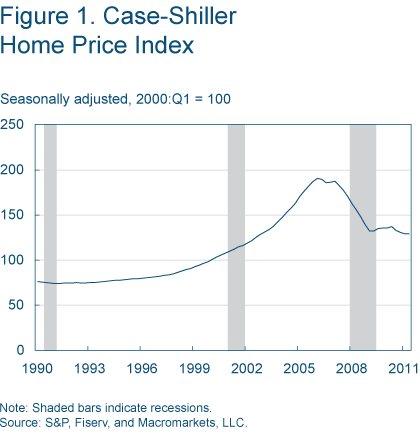
Note: Shaded bars indicate recessions.
Source: S&P, Fiserv, and Macromarkets, LLC.
Recalculating Property Taxes
When residential property values fall, the impact on local government budgets depends not only on the extent of the losses but also on when the losses are realized relative to the budget cycle. The timing can vary by state, and it depends on how property values are calculated. While most states use appraisals to estimate the market value of property, they update these estimates in very different ways. The way estimates are updated can have a significant impact on whenthe losses in property values are realized.
California, for example, reappraises the value of properties for tax purposes whenever ownership of the property changes. This forces cities in California to reduce the
taxable value of a property when it goes through foreclosure. With foreclosures fi guring so prominently in the past recession, this reappraisal mechanism has contributed to the budget challenges now facing California cities, as losses are realized immediately with every foreclosure.
Ohio, on the other hand, reappraises the value of properties for tax purposes every six years. While minor revisions are made between these formal appraisals, the methods are imprecise and they can miss big changes. Because a number of Ohio counties have yet to undergo the formal reassessment since the last recession, the full impact of the recession on property taxes and local government budgets may still lie ahead for many places.
Cuyahoga County is a case in point. One of Ohio’s interim revision methods is to adjust the estimated tax value of properties every three years based on the prior three years of property sales. Cuyahoga County (home to Cleveland) will undertake its formal reappraisal in 2012, along with 19 other counties. The last formal appraisal, in 2006, occurred near the peak of the market in Cuyahoga County. The 2009 adjustment included sale prices from 2006, a fairly strong year for the housing market. So even the adjusted property values in Cuyahoga County do not likely reflect the impact of recent housing price declines. Home values have continued to fall since the last adjustment, suggesting that there may be a large correction upon reappraisal.
Cuyahoga County: A Case Study
We estimated the loss in value that Cuyahoga County’s property tax base might realize after its 2012 reappraisal. We started by acquiring the county’s 2010 estimates of the market value of every taxable parcel of land in Cuyahoga County (“county estimates”).
Next, we listed the sales prices of all residential properties sold for amounts over $0 (including foreclosure sales) from 2006–2010. If a parcel was sold multiple times in a single year, we took only the last sale in that year. We used the sales prices to estimate the current market value of homes (“market estimates”). Some properties are sold for $0, but the vast majority of these—transfers to trusts, interfamilial transfers, or other non-arms-length transactions—would provide no information about market value, so we exclude them.
The only type of $0 transaction that might reflect market value is a transfer of property to a land bank. Transferring a property to a land bank should only occur when the property has no net value, which happens when the sum of the property’s rehabilitation costs, including accrued code violations and property taxes, carrying costs, and transaction costs, are greater than the property’s expected value. If we included these transfers, it would lower our market estimates somewhat, depending on how many of these transfers there are.
Finally, we compared the county estimates and the market estimates and calculated the annual gain or loss for each property. When the market estimate was higher than the county estimate, we would expect a gain after reappraisal. When the market estimate was lower, we would expect a loss after reappraisal.
It should be noted that the actual 2012 appraisal values will vary from our market estimates for a few reasons. First, we look only at residential property (both single and multifamily), and we use sale values that may be stale. When a property last sold in 2006 or 2007, we use that as our estimate of market value for 2012 despite the decline of home values since then.
Second, our market estimates will be based on a sample that may not be representative, because we can only observe sales that occur. Blighted properties may not sell, just as properties in distressed neighborhoods may not sell. Conversely, people who own high-value properties may hold onto them in the hope of a market rebound.
Third, the actual reappraisal will consider 2011 sales information, which we do not yet have. Fourth, in 2012, appraisals will be “drive by” appraisals—so only the exterior of the home and neighborhood will be viewed. This will not reveal any substantial improvements inside the home, damage inside the home, or other defects such as cracks in the foundation.
Finally, appraisal is at least as much an art as it is a science. Deciding which properties to use as comparables and the extent to which home values should be adjusted based on neighborhood factors will vary depending on the appraiser.
As shown in figure 2, our market estimates give cause for concern. In 2006, when the last appraisal was conducted, and in 2007, market estimates of properties that sold exceeded county estimates. But since 2008 this trend has reversed. The differences between the market and county estimates from 2008 through 2010 imply that when property values are reassessed in 2012, they will be between 11 percent and 18 percent lower than the 2010 county estimates. The loss observed on property sales suggests that after reappraisal, the county tax base will be at least $1.1 billion lower than it was in 2010. But this dollar value estimate is based on the
roughly 65,500 properties that were sold between 2008 and 2010, and assumes all other property held its value.
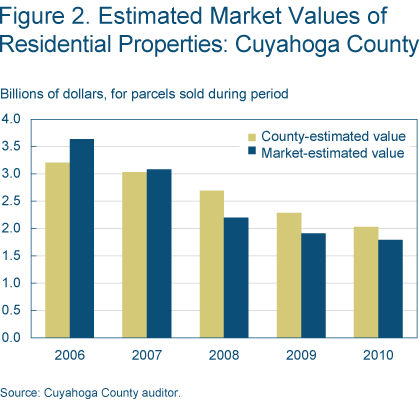
Source: Cuyahoga County Auditor
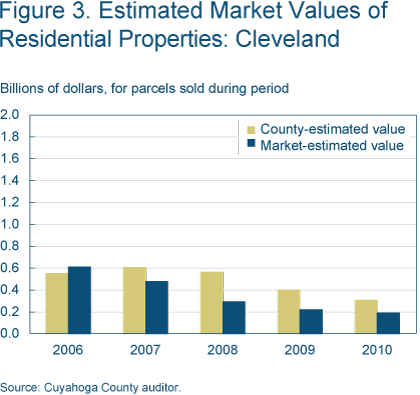
Source: Cuyahoga County Auditor
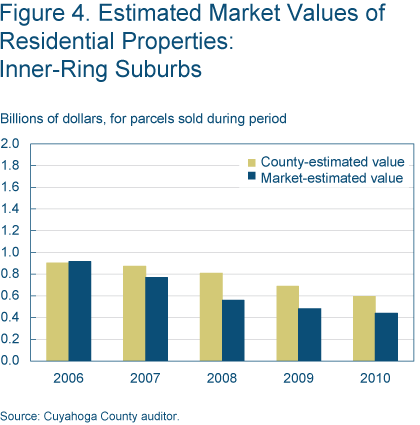
Source: Cuyahoga County Auditor
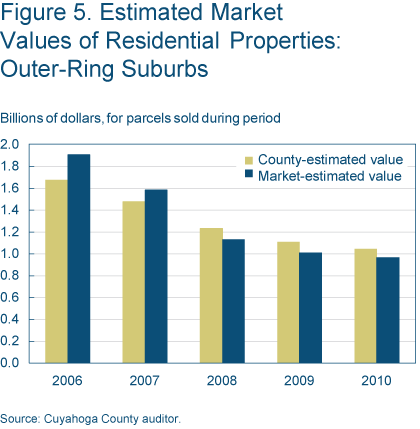
Source: Cuyahoga County Auditor
Cleveland, Inner-Ring, and Outer-Ring Suburbs
The declines in property values and the tax base are not distributed evenly across Cuyahoga County. The impact has been felt most strongly in Cuyahoga’s central city (Cleveland) and its inner-ring suburbs (those that border Cleveland). The outer-ring suburbs have not been hit as hard. All of these areas have followed a similar pattern since the 2007 recession: Market estimates exceeded county estimates in 2007, and sometime thereafter the trend reversed and county estimates exceeded market estimates (figures 3–5).
In Cleveland and the inner-ring suburbs the reversal began in 2007. In the outer-ring suburbs it began one year later. But the relative differences between the county and market estimates are larger in Cleveland and the inner-ring suburbs than in the outer-ring suburbs. This suggests that property values have fallen to different extents across the county.
Table 1 contains the implied decline in property values calculated by comparing the market and county estimates. Again, keep in mind that the numbers are estimates, as looking only at the properties that sold is not a representative sample of taxable properties and the actual appraised values may vary for the reasons discussed earlier. Our non representative sample suggests that the outer-ring suburbs will fare best after the reappraisal, with new values coming in about 8 percent lower than they were in 2010.
| Implied change 2008 (percent) | Implied change 2009 (percent) | Implied change 2010 (percent) | |
|---|---|---|---|
| Cuyahoga County | -18 | -16 | -11 |
| Cleveland | -48 | -45 | -38 |
| Inner-ring suburbs | 31 | 30 | -26 |
| Outer ring suburbs | -8 | -9 | -8 |
Source: Cuyahoga County auditor.
While this decline is relatively minor, any decline will present a new challenge that municipalities have not faced during or after prior recessions. According to local policymakers, market estimates of properties that sold have always exceeded county estimates. If our calculations are even close, the 2012 reappraisal will be a first.
Things look more troubling in the inner-ring suburbs and Cleveland. After the 2012 appraisal, the inner-ring suburbs may see property values fall 26 percent to 30 percent lower than the 2010 county estimate. Cleveland’s appraisal may be 38 percent to 45 percent lower. If appraisals come in close to this far below the 2010 county estimates, Cleveland and the inner-ring suburbs may face a significant tax revenue shock in 2012.
Implications for Tax Collections
Fortunately, large declines in the reappraisal values will have smaller effects on tax collections. In Cuyahoga County, residential property taxes are calculated by multiplying the tax rate of the district by 35 percent of the value of the home as appraised by the county. Basing property taxes on a percentage of the tax estimate reduces the impact of fluctuations in estimates on tax revenues. Governments sometimes use a value stabilizer in property tax calculations similar to that of Cuyahoga County, providing some protection against such steep declines in value.
This value-stabilizing feature would likely make the implied 8 percent decline in outer-ring-suburb property values have a small impact on property tax collection. However, any loss is unprecedented in the outer-ring suburbs, so the small loss could still cause problems in a post-recession environment experiencing sluggish recovery, where sales and income tax revenue remain low.
In Cleveland and the inner-ring suburbs, the impact on tax revenues might also be substantially lower than our market estimates imply. First, for many properties, any decline in the appraisal value will have no impact on tax collections. Residential property may be in a period of tax abatement, when no tax is owed on the property. This is particularly important in Cleveland, which has abated taxes on some new residential construction in order to draw new home owners into the city.
Second, not all residential property owners pay taxes. On average, 52,000 properties in Cuyahoga County are nontrivially tax-delinquent in a given month, which represents nearly 10 percent of the parcels in the county. (Whitaker, Fitzpatrick 2011) Any decline in the value of these properties will have no impact on tax collections, since nothing is being collected. For example, according to Cleveland’s 2009 Comprehensive Annual Financial Report (available through the Division of Financial Reporting and Control), the city collected roughly 60 percent of real property
tax revenue owed in 2008 and 2009. But if the implied change is close to the reappraisal value, the impact on tax collections in the central city and inner-ring suburbs could be significant, amplifying their budget issues. Implied declines of 30 percent or 40 percent of residential property values suggest large declines in property taxes, even considering the value-stabilization feature of the tax revenue calculation. Other states that adjust their tax estimates using methods similar to Ohio’s may also see municipal budget crises amplified by the fall in property values.
If creative ways to make up for this lack of revenue are not found, local governments may face the undesirable choice of either raising property taxes or reducing funding for essential services. Both actions may make the municipality a less desirable place for new home owners to locate. Weakening housing demand may lead to further declines in property values. In any case, it appears that the dramatic fall in property values across the country will accelerate the financial distress of municipalities in the wake of the Great Recession.
Suggested Reading
- “Ohio’s Land Banking Legislation: Modernizing an Aged Model,” by Thomas J. Fitzpatrick IV, 2010. Journal on Affordable Housing and Community Development Law, vol. 19:3.
- “The Impact of Vacant, Tax-Delinquent, and Foreclosed Property on Sales Prices of Neighboring Homes,” by Stephan Whitaker and Thomas J. Fitzpatrick IV, 2011. Federal Reserve Bank of Cleveland working paper no. 11-23.
The views authors express in Economic Commentary are theirs and not necessarily those of the Federal Reserve Bank of Cleveland or the Board of Governors of the Federal Reserve System. The series editor is Tasia Hane. This work is licensed under a Creative Commons Attribution-NonCommercial 4.0 International License. This paper and its data are subject to revision; please visit clevelandfed.org for updates.
Suggested Citation
Fitzpatrick, Thomas J., IV, and Mary Zenker. 2011. “Municipal Finance in the Face of Falling Property Values.” Federal Reserve Bank of Cleveland, Economic Commentary 2011-25. https://doi.org/10.26509/frbc-ec-201125
This work by Federal Reserve Bank of Cleveland is licensed under Creative Commons Attribution-NonCommercial 4.0 International
- Share




